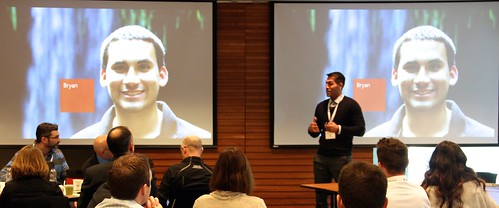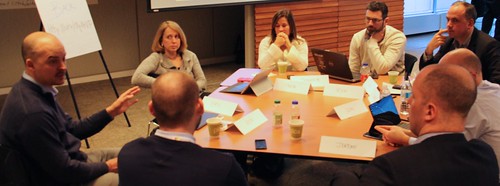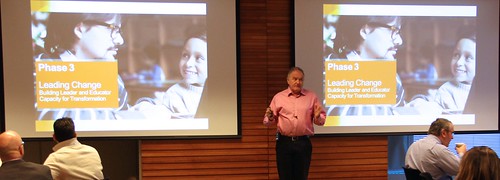| Reflections on the Design, Deploy, & Transform Workshop | |
| Author: Justina Spencer, AALF Communications | February 18th, 2015 | |
|
I recently attended a Design, Deploy, & Transform workshop held at the Microsoft campus in Ottawa, Ontario. AALF President Bruce Dixon led the two-day, hands-on event in partnership with Microsoft. Bruce has run this workshop globally over the past few months in cities such as London, UK, Brussels, Belgium, and Tbilisi, Georgia. School leaders as well as some teachers from four different school boards across the Ottawa area were in attendance. While the teams varied in size, they represented a cross-section of educator leaders seeking to drive change in their schools. Although I am familiar with the Design, Deploy, & Transform framework through my work with AALF, this was my first opportunity to see the workshop in action and witness first-hand how the framework addresses educators’ challenges around 1:1 and sparks new ideas around the role of schools for modern learners. The Design, Deploy, & Transform framework is designed to walk educators through best practices of 1:1 initiatives and prompt discussion around 21st century learning. Since the first 1:1 programs began more than 25 years ago, tens of thousands of schools across the globe have piloted or fully deployed 1:1 programs in their schools and school districts. Analyses of their experiences reveal that the most successful 1:1 initiatives have one main characteristic in common: they are first and foremost concerned with learning, not laptops. The successful initiatives also followed a similar set of processes, whereas the schools that reported the most problems did not. Thus, the Design, Deploy, & Transform framework is centred on key aspects of these initiatives’ system-wide approach. It is intended to help school leaders envision, plan, implement, evaluate, and expand 1:1 learning in your schools. The framework is divided into five phases that begin with a high-level perspective focused on vision and strategy, and progress to more tactical issues and specifics relating to the varying scheduling, communication, and technical needs of each program. In Ottawa, complimenting the discussions led by Bruce, were talks given by Dr. Ginno Kelley, Microsoft Director of Teaching and Learning of the Americas, who delivered a thought-provoking presentation on intriguing software that can be used to garner more student interest and participation, and a session led by Martha Jez from Fair Chance Learning who talked about the issue of accessibility and demonstrated software tools designed for students with disabilities. The tone of the workshop was set early on when Bruce asked participants to think about their expectations regarding technology in learning. After a bit of a discussion, the educators were challenged to think about what students who have grown up in a technology-rich world expect when using technology in the classroom. It was clear that it is time to re-examine every aspect of learning based upon this new world. “Bringing technology to the classroom is like an iceberg,” remarked one teacher, “my eyes are really open to how big this really is.” After a day spent discussing the necessity for change in our schools in lieu of the technology-rich world in which children are immersed, developing a vision and goals for 1:1 programs, and the various opportunities around learning that technology enables, the second day began with a discussion around the new roles for teachers. Afterwards, Bruce moved into the strategies required for bringing these ideas to fruition. Without effective strategies for creating a change culture, communicating, financing, and supporting educators, the well conceived vision, and new view of learning will remain just that – ideas and not actions. Other thought-provoking moments from the workshop included a discussion around the difference between professional development and professional learning. The framework drives home the point that professional development is something that is done to you, and professional learning is something you own yourself as an educator. In order to see self-directed learning in students, you need self-directed teachers who seek out their own learning. In terms of more tactical issues covered by the framework, one activity centred around developing school policies on web 2.0 access, the use of games or personal software in school, charging batteries and storage concerns, and backup management. This activity generated discussion around such issues as class management, ‘after-hours’ help, and web 2.0 tools that can bring pedagogical value. The workshop balanced both presentation type discussions with activities in which the school leaders had the opportunity to tackle some of the questions they’ll need to lead and understand as they move to 1:1. It was a jam-packed two days. After attending the workshop and reflecting on the discussions that ensued, it was evident that schools must first work hard on developing a vision for their schools—there must always be an overarching, actionable vision and a clear understanding of how and why the learning environment should shift. This was echoed by a participant who remarked that the challenge at his school was “moving mind-set and changing thinking amongst teachers.” He continued that establishing a vision and building a foundation “has changed my thinking and I can bring that back [to the school].” In addition to establishing a clear vision, it was apparent that while there are challenges along the road for any school heading down the path to 1:1, it is crucial that focus be placed on re-thinking all aspects of the learning environment, as opposed to just making small changes – ‘tweaks. School leaders need to ask three vital questions – what should they keep? What should they get rid of? What should they add? The second question often is the most challenging, but as essential as the other two. Attention must always be focused on the learning opportunities now possible, not the challenges and difficulties. Once the vision has been crafted, steps must be taken to move forward with the chosen goals, and the Design, Deploy, & Transform framework guides every step of the way. Justina Spencer is AALF's Communications Manager |
|
« Return | Top
 |
| This article is licensed under a Creative Commons License |










